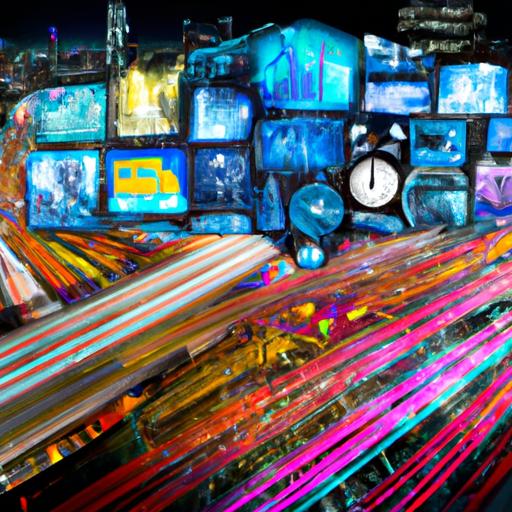The 4th industrial revolution represents a monumental shift in the way we live, work, and interact with technology. This transformative era is characterized by the fusion of digital, physical, and biological systems, leading to unprecedented advancements in automation, artificial intelligence, and connectivity. As we navigate through this fast-paced revolution, it becomes crucial to grasp the timeline of key developments shaping our future.
In today’s rapidly evolving landscape, staying informed about the progression of the 4th industrial revolution is not just a choice but a necessity. By understanding the timeline of this revolution, we can anticipate upcoming innovations, adapt to changing industries, and harness the potential opportunities that lie ahead. Join me on a journey through the timeline of the 4th industrial revolution, where we explore the past, present, and future of this groundbreaking phenomenon.
Definition of the 4th Industrial Revolution
What is the 4th Industrial Revolution?
The 4th industrial revolution signifies a paradigm shift in the way technology integrates with various aspects of our lives. This era is characterized by the convergence of digital, physical, and biological systems, leading to a new wave of innovation and transformation across industries. It represents a fusion of technologies that blur the lines between the physical, digital, and biological spheres, reshaping the way we live and work.
Key Technologies Driving the Revolution
Several groundbreaking technologies are driving the 4th industrial revolution forward, revolutionizing the way we interact with the world. These include artificial intelligence, robotics, the Internet of Things (IoT), big data analytics, nanotechnology, and biotechnology. These technologies work in harmony to automate processes, enhance efficiency, and create new opportunities for growth and development. By leveraging these key technologies, industries can unlock new potentials and navigate the complexities of the digital age with agility and innovation.
Historical Context of Previous Industrial Revolutions
The 1st Industrial Revolution
The 1st industrial revolution, often referred to as the “Mechanization Revolution,” marked the transition from agrarian societies to industrialized economies. With the introduction of steam power, mechanized production processes, and the rise of factories, this era brought about significant changes in manufacturing, transportation, and communication.
The 2nd Industrial Revolution
Following the 1st industrial revolution, the 2nd industrial revolution, known as the “Technological Revolution,” emerged with advancements in electricity, mass production, and the development of the assembly line. This period of innovation transformed industries, leading to increased productivity, urbanization, and economic growth on a global scale.
The 3rd Industrial Revolution
The 3rd industrial revolution, also known as the “Digital Revolution,” introduced the widespread adoption of computers, telecommunications, and the internet. This era saw the rise of information technology, automation, and interconnected systems, revolutionizing how we communicate, work, and access information.
Reflecting on the historical context of previous industrial revolutions provides valuable insight into the patterns of innovation, societal transformations, and economic impacts that have shaped our world today. Understanding the evolution of these revolutions sets the stage for comprehending the current landscape of the 4th industrial revolution and its implications for the future.
Timeline of the 4th Industrial Revolution
Early Developments in Automation and Digitalization
The 4th industrial revolution began with early developments in automation and digitalization, laying the foundation for the integration of technology into various aspects of our lives. Innovations such as robotics, machine learning, and the Internet of Things (IoT) paved the way for a more interconnected and efficient world.
Key Milestones in the Evolution of Industry 4.0
Throughout the evolution of Industry 4.0, several key milestones have shaped the trajectory of this revolution. From the introduction of smart factories to the rise of data analytics and cloud computing, each milestone has brought us closer to a future where technology drives innovation and productivity in unprecedented ways.
Current Trends Shaping the Future of the Revolution
As we look towards the future of the 4th industrial revolution, several trends are emerging that will continue to shape the landscape of Industry 4.0. From the increasing focus on sustainability and renewable energy to the growing importance of cybersecurity and data privacy, these trends reflect the ongoing transformation of industries and societies worldwide.
Implications of the 4th Industrial Revolution
Changing Industries and Businesses
The 4th industrial revolution is reshaping industries and businesses across the globe, introducing new paradigms and disrupting traditional models. Automation, artificial intelligence, and big data analytics are revolutionizing production processes, enhancing efficiency, and driving innovation. As businesses embrace digital transformation, they are redefining their operations, business models, and customer experiences to stay competitive in this dynamic landscape.
Challenges and Opportunities Presented by Industry 4.0
While the 4th industrial revolution brings about unprecedented opportunities for growth and advancement, it also presents unique challenges that organizations must navigate. From upskilling the workforce to cybersecurity concerns and ethical implications of AI, businesses face a multitude of hurdles in harnessing the full potential of Industry 4.0. By addressing these challenges proactively and leveraging the opportunities provided by the revolution, companies can thrive in the digital age and pave the way for a sustainable future.
Conclusion
In conclusion, delving into the timeline of the 4th industrial revolution unveils a world of endless possibilities and challenges. As we witness the rapid evolution of technology and innovation, it is imperative to stay informed and adaptable in this dynamic landscape. By embracing the changes brought forth by Industry 4.0, we can pave the way for a future where efficiency, connectivity, and sustainability converge to shape a new era of progress.
The timeline of the 4th industrial revolution serves as a roadmap for navigating the complexities of a digital age, where disruption and transformation go hand in hand. Let us seize the opportunities presented by this revolution, harness the power of innovation, and embark on a journey towards a future where technology and humanity coexist harmoniously. Embrace the timeline of the 4th industrial revolution, and together, we can redefine the way we live, work, and thrive in a world driven by relentless innovation.
